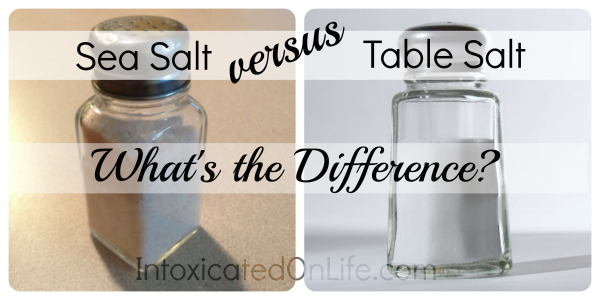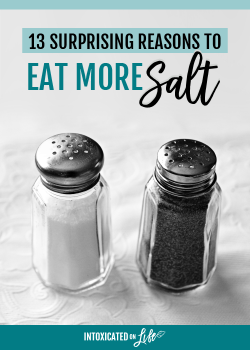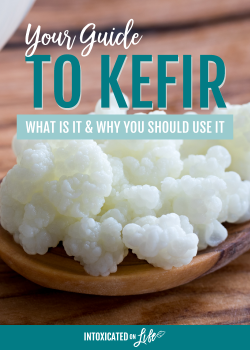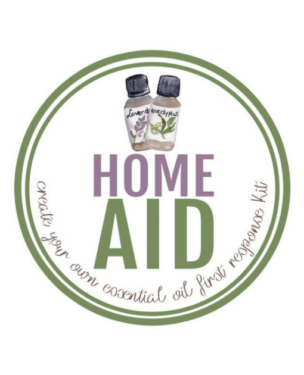Sea salt, table salt—what’s the difference? A quick search online and you’ll find a multitude of opinions on the matter. This month’s wellness challenge is to change the kind of salt you use. In this post and I’m going to compare the two and you can decide for yourself which you’d rather be putting in your body. I have a feeling I know which one you’ll choose!

How Table Salt and Sea Salt are the Same
- They both originate from sea—either straight from the sea or from an inland ocean bed.
- They both have approximately 40% sodium content (this varies a little bit in different types of sea salt).
- They both make your food taste salty.
That is where the similarities stop.
Table Salt
The process table salt and seal salt go through, from the collection of of the salt to when it appears on your table, is vastly different.
- Table salt is heated to over 1200 degrees fahrenheit under high pressure. The heating, processing, and filtering of salt strips it of all naturally occurring minerals.
- Chemicals are used to bleach the salt and also to give it it’s anti-caking and clumping properties.
- Table salt has added iodine. At first, this may seem like a good thing; we need iodine. Many individuals who live in the Midwest are iodine deficient because the soil in this area of the world is iodine deplete. The problem is, the iodine added to salt is only about 10% bioavailable. That means, for every 100 micrograms of iodine you ingest via salt, only 10 micrograms is available for your body to use. There are much better sources of iodine than salt!
- Dextrose (aka corn sugar) is often added to to your salt to stablize the iodine. Without the dextrose, the iodine in the salt would decompose. Isn’t that fun—added sugar (probably sugar from GMO corn)!
Unrefined Sea Salt
Compared to table salt, unrefined sea salt is pretty bland (well, not to the taste buds…quite the opposite).
- Unrefined sea salt is obtained via evaporation of sea water or from ancient inland ocean beds. Unrefined salt from reputable companies will not be heated, or heated at very low temperatures.
- Since unrefined salt is unprocessed it retains all of it’s trace minerals (there are 80+ trace minerals in sea salt depending on the type of salt you’re using).
- Iodine is not present in large amounts in sea salt, but it is in small amounts. These trace amounts found in sea salt are much more bioavailable than those found in iodinzed salt. Again, the amount of iodine in your salt will vary depending on what type of salt it is.
A Word of Warning about Sea Salt
The term “sea salt” can be a deceptive misnomer. Be forewarned that all “sea salt” is not created equal. Virtually all salt makers can claim their salt is “sea salt” because at one point it came from the sea. There are some brands of sea salt on your grocery store shelves (I’m not going to name names) that are pretty much regularly processed and bleached salt (minus the iodine) repackaged with a pretty “sea salt” label.
So, how can you tell the difference between processed and unprocessed salt? True unrefined sea salt will rarely be pure white. It will range in colors—pink, grey, tan, sandy, black. It’s also good to investigate how the salt you’re purchasing is processed being sure it’s unrefined.
I personally enjoy using Himalayan pink sea salt and have also recently begun to enjoy Real Salt. Not only is it delicious but it proves to be one of the sea salts with the most minerals. I also appreciate that the salt tables it is mined from have been protected from modern pollution. I’ve also read great things about Celtic Sea salt. It would be another fantastic option to replace table salt. I’m sure there are other wonderful options out there too.
If you’re looking for another fantastic reference on salt, Real Salt has put together a very comprehensive booklet available as a free download.










We love our Himalayan salt! :o)
This is great information. I never really thought about the difference between table salt and sea salt.
Thanks for the write-up on salt. I was actually wondering what the difference was and I think I’ve got that regular old kind that has a prettier label. Grr!
How do you know if your olive oil is pure? Are you sure it hasn’t been watered down with a cheaper vegetable oil? There’s only one way to tell (and the label has nothing to do with it). I shared a simple two-step process for determining the purity of your olive oil. I also shared a how-to guide for buying, storing and cooking with olive oil… get that oil off the counter and away from the stove!
Sounds like a great post! I’ve read that you can’t trust the label on olive oil (so sad).
Wow this is great information. I did not know about the dextrose and we are avoiding corn due to food allergies! No wonder we can’t get a handle of his eczema!
Now I am on a hunt for Himalayan or Celtic sea salt. Thank you so much for this information.
You’re very welcome! Isn’t it frustrating when you think you’ve got it figured out only to find out you’ve been eating something wrong. Argh. That happened to us. We have cut out corn as well, but didn’t realize that citric acid was made from corn!
It is definitely frustrating, especially when the breakouts are horrid and you are spending so much money trying to make it better only to realize you were exposing him EVERYDAY!
A while back we were looking into using sea salt but never got around to it. Now I definitely have motivation!
Thank you! I had no idea about the difference between table salt and sea salt- all I’ve heard is that all salt is the same. Now to try and find some Himalayan salt. Thank you!
I haven’t been able to find any good sea salt at my local grocery stores, but we don’t live anywhere with good specialty stores or health-food stores. Amazon and Saltworks.com both carry great salts though!
I think the biggest benefit of using sea salt is how great it tastes. This has been one of my favorite real food switches that we’ve made.
Himalayan girl here!! Love it! Will never buy regular old table salt again.
I recently saw some Hawaiian salt at TJ Maxx (amazingly, my favorite place for Himalayan salt). Any idea about that? It was a gorgeous deep pink color, so I’m sure it was good for you! Just wasn’t sure how it compares to Himalayan, so I didn’t get it. 🙂
I imagine if the salt has a lovely color and isn’t a bleached white color, it’s likely good for you. I know the different types of salts have different mineral rations. I need to try more salts! There are such a wide variety of them.
Is the costco Himalayan sea salt safe?
I’m sorry, I’ve not had a chance to check it out.
Thanks for the comparison. I do use unrefined pink salt. But, I was wondering about the 1200 degree information. I keep trying to find confirmation that this is actually the case. I can see a website where they specifically mention that salt is dried at 365 degrees to speed up evaporation, but I can’t find any confirmation of the 1200 degrees. Do you know what part of the salt production process this is used in and why they would need to heat it such a high temperature. Thanks for any information!